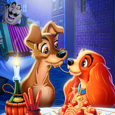DisneyToon Studios (February 27 2001), Walt Disney Home Entertainment (August 21 2012), Blu-ray and DVD discs, 69 mins plus supplements, 1080p high definition 1.78:1 widescreen, DTS-Master Audio 5.1, Rated G, Retail: $39.99
Storyboard:
Set right after the events from Walt Disney’s 1955 classic, Scamp’s Adventure picks up as Lady and the Tramp’s puppies are still growing up and finding their place. Scamp, like his father before him, yearns for adventure and the fun life. Tramp himself seems settled with Lady and their three girl pups and tries to instil in Scamp a sense of family and responsibility. When Scamp pushes things once too far with the dogs’ owner Mr Darling, he is tied to a post in the yard until he can calm down. Breaking his leash and seeing the chance for “freedom”, Scamp runs off into town, coming across the Junkyard Dogs – a bunch of strays who live the easy life – and meeting Angel, who secretly dreams of a life she’s never known: as a pet with a loving family. Soon Scamp is forced to decide between the wild life and the home life when the stray dogs’ leader Buster moves in on Angel, and leads Scamp into trouble a little too close to home…
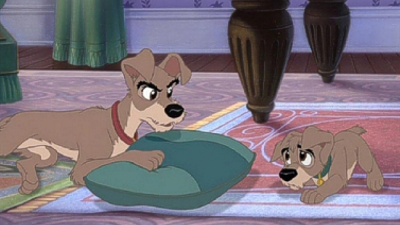
The Sweatbox Review:
Easily one of the better of the ultimately (and largely thankfully) short-lived series of direct-to-video outings that Disney seemed focused for around a decade from the mid-1990s, Lady And The Tramp II: Scamp’s Adventure rates highly among this litter, probably down to being one of the later films to emerge from the Studio’s television animation division. The first of these “sequels”, such as the Disney Channel quickies like those that completed the “Aladdin Trilogy” (with all those helpful fade-outs ready for commercial placing!) and misguided follow ups to Cinderella and others, were what quickly gave these films their “cheapquel” nickname among fans, but over time – and with a name change to DisneyToon Studios offering some kind of validity – and a focus on more recent fare, the offerings and the artistry itself began to improve to the point where a new Toon Studio production was potentially more anticipated than the likes of Feature Animation’s Chicken Little-style output.
While still not up to the originals’ classic standards, of course, both Jungle Book 2 and 101 Dalmatians II: Patch’s London Adventure turned the tide a little, being rudimentary and ultimately inconsequential feature, but with a brisk light touch that recalled the tone of the older films, with Patch at least developing the characters a little more. Regular readers may also remember that Return To Never-Land, the Peter Pan sequel that was the first of these films I actually sat down to watch with my full attention (I’m not counting The Rescuers Down Under among these spin-offs, as that was an official Feature Animation theatrical film), hit some kind of positive nerve in me, even going as far as to place it among the then-recent traditionally animated films such as Mulan and Tarzan that honored the classic storytelling techniques of Walt himself.
Possibly a little too higher praise for some (and subsequent viewings have dampened my enthusiasm a little), but at the time I found Never-Land to be a colorful showcase for the Australian Disney animation department that revealed the potential of what they could be capable of. Having not been at all interested in these sequel films up until this point (the sequences I did see at the time of Little Mermaid II and the Pocahontas follow up – also concurrently out on Blu-ray – did not inspire too much confidence!), it wasn’t really until I got the opportunity to review them that I took any kind of notice. Such was the same case as with this continuation of the Lady And The Tramp story, which originally completely passed me by until its second DVD release a few years ago. Now in HD, and with a new outlook on these films coupled with the temptation of revisiting some beloved characters, it’s again time to look back on the film, and again I must say that I’m still very impressed indeed.
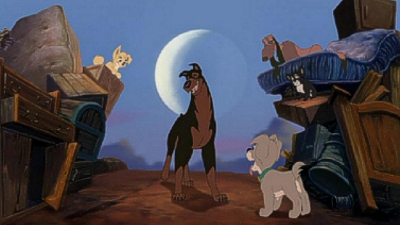
As with the other continuations of the Disney classics, and in practically every one of these DTV movies, there are elements that get re-played from the original films in an attempt to link the two endeavors together. The DTVs usually broke down into two camps: the “mid-quel” attempt at filling in “gaps” from the original movie (Bambi II, Tarzan II), or otherwise the very mundane “child of the original protagonist re-steps their parents’ adventure”. Here, the romance between Scamp and Angel is the Lady/Tramp relationship all over again, but for some reason this re-hashing of such scenes doesn’t feel like a complete rip-off. There is a sense of the familiar, but then the scenes are staged from slightly different perspectives allowing even fans of the original to re-live a favorite moment with more of a sense of déjà vu than the feeling of watching a carbon copy. For instance, the inevitable spaghetti scene plays as a very sweet “reminder” moment, which I for one was surprised I didn’t automatically roll my eyes at.
Many were quick to jump on these sequel films as each was released, including me, and Walt himself was famously opposed to the very idea of sequels to his animated films. “You can’t top pigs with pigs!” he is said to have commented at the idea of more Three Little Pigs cartoons, but even he did eventually cave in, producing The Big Bad Wolf, Three Little Wolves and The Practical Pig shorts in the series. He also allowed additional films to many of his live-action hits, with Son Of Flubber following The Absent Minded Professor and a string of Merlin Jones/Medfield College mis-adventures continuing for a couple of decades. Lady And The Tramp itself was followed by a number of additional stories in printed comic book form, where Scamp himself became something of a leading character with his own strip, and it is these tales that closest inspire Scamp’s Adventure.
Not all the DTV titles succeeded in their aims, obviously, with most of them deserving their ultimate routes to the bargain bins and eventual television-trapped futures. However, as with Return To Never-Land and here with Scamp’s Adventure, every now and then one escaped from the bag and went some way to proving that Disney still had the magic touch even through the dark times when hand-drawn animation seemed dead at the very Studio that nurtured it. No, these films were not original stories (and it would be a while before we could see what this crew could come up with given a new idea), but for a long stretch they were the best way to see the kind of Disney features we remembered from our childhood and throughout the renaissance of the 1990s. Some may scream sacrilege, and in some cases with significant warrant, but Scamp’s Adventure really does deliver that old musical magic.

Despite not being shot in the CinemaScope widescreen ratio of the first film (it would have been nice for consistency, though it is correctly framed for 16:9), Scamp’s production design is very much in keeping with the original. The backgrounds especially evoke that clean turn of the century atmosphere, and the animation on the whole is a very close match to the style used in the 1950s at Disney’s. Characters are rounded, lip-sync is good and movement, while not being able to draw on the services of Walt’s Nine Old Men’s talents, is at least smooth and more than just serviceable. We’re also not restricted (as with most of the sequel films) to simply a repeat showing of the original cast either, with several new characters making their debuts.
Lead director Darrell Rooney and his collaborating filmmakers should be praised for this, for how easy would it have been to just re-use Peg and the rest of the down and out dogs for the sake of simplicity? Here, they take the bold step of not re-introducing any of the characters they do not need to, and considerably expand on existing ones (Scamp’s three sisters, for example, each have defining personalities). Best of all is the dogcatcher, whom one would absolutely swear is a grand return to Disney voice work by Don Knotts. Resembling the actor both vocally and in appearance, and even though Scamp’s production predates the classic comedian’s death (indeed, he was also the hysterical turkey mayor in the Studio’s Chicken Little), the dogcatcher is actually voiced by regular Disney voice artist Jeff Bennett, who also helps Tramp to sound the same as he did 45 years before.
Joining Bennett in the voice cast is a pretty decent selection of voice talent. He also provides Jock and Trusty’s not-a-pitch-different-than-the-original’s vocal tones, while Jodie Benson is instantly recognizable as Lady. The almost appropriately named Scott Wolf voices Scamp, and he comes across exactly as one might imagine from the original Disney comics. Roger (Hercules) Bart sings for the young pup, and the music score is perhaps the best, and certainly most “traditional”, of the DTV canon (Scamp’s A World Without Fences is as classic a Disney “I want” number as any, coming across with just the right amount of frustration and triumph). Scamp’s love interest, Angel, is played here by Alyssa Milano (a then popular-with-the-boys young female star for, ahem, certain reasons), and plays it as how one might imagine Peg might have been back in her show dog days, a free spirit not content to just hanging out with the ruff dogs in town, knowing that she needs something more.
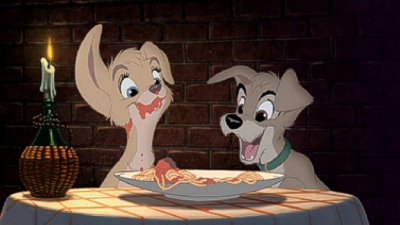
Whereas Lady needed the protection of Tramp in the outside world, here things are played differently. Not simply a reversal of roles like many of the sequels were content to provide, here the two dogs are on equal footing and must work together as a team to outwit their various opponents and survive. The story offers much to entertain, though those vehemently against these films will also find much to pick it to pieces with, in the return to Tony’s restaurant for more spaghetti, or the climatic chase sequence, etc. But I found it to be a nice updating of the story that obviously leans a little more to the kids’ tastes of today than the 1955 original did: less kitchen sink drama and more lightness of touch, which isn’t such a bad thing to be honest.
However, the film remains part of the same visual world; nice nods back to the first film also pop up in the backgrounds, such as the sidewalk where Lady and Tramp left their paw-prints, and one great touch has the scrap heap-dwelling villain living in the old cart that held Tramp captive and featured so prominently during the final chase sequence in the original. Of the animation itself, Scamp falls somewhere in the middle of the Disney Studios quality level, if one subscribes to the “three-tier system” theory. Obviously there are the “classic” features, created in rich and deep full animation and employing all the tricks of the trade at their disposal. At the other end of the spectrum is Walt Disney Television Animation, which produced the animated series as well as many of the early DTV movies.
Some of these were always intended for TV broadcast, animated in the “Saturday morning” style with cost-cutting techniques and a somewhat rushed approach to the visuals (the Aladdin, Cinderella, Pocahontas and Mermaid sequels especially follow this heavy “black marker” outline look). Originally borne from the TV group and eventually becoming DisneyToon, first based in Canada and then Australia (where the crew down under continue to churn out new entries in the Tinker Bell franchise), the later DTVs exhibit a feel that comes from somewhere in the middle of the two ranges – product that, while just not quite reaching the dizzying heights of the full Feature Animation output, at least makes a good stab at maintaining those quality levels.
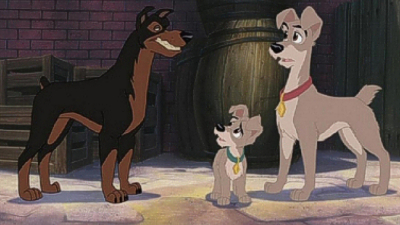
The quality change seemed to be signposted by The Lion King II: Simba’s Pride and was eventually bettered by The Lion King 1½: Hakuna Matata, itself mixing footage in from the first The Lion King to exemplary effect so as to be virtually indistinguishable from the original. Unfortunately, the DisneyToon-ers perfected their hand-drawn craft just as the decision was made to switch to CG production, so we never really got a chance to see a non-sequel or franchise picture from them, but it is not unnoticed that this is the crew that gave us the Lion King, Peter Pan and Scamp films, with Lilo And Stitch and a further, much better third Cinderella then still to come – titles that, oddly enough, rank among the best that Disney’s direct-to-video sub-genre had to offer.
But Scamp’s Adventure really does give the hand-drawing artists at Disney’s Australian studio the chance to shine, from the standard contract voice-players to folks such as Danny Troob, a long-time associate of Alan Menken and arranger/orchestrator of many a Disney score, who provides and conducts the music here. Others who have their moment in the spotlight are directors Darrell Rooney and Steve Trenbirth, both of whom should really have followed the likes of Kevin Lima to go on to directing bigger budget features of their own. Making return trips to Disney are voice actors Jodie Benson (Lady) and Mickey Rooney (Sparky), while Melissa Manchester (The Great Mouse Detective) and Norman Gimbel (probably best known for the Wonder Woman TV theme) keep the song quality up, with additional singing work by Susan Egan (Hercules’ Meg).
Lady And The Tramp II: Scamp’s Adventure, despite a slightly ridiculous title (how could anyone really take anything called Lady And The Tramp II seriously, for Pete’s sake!?), manages to rise above the pitfalls and potential negative connotations that being a DTV title may suggest. It may not be the top dog that Walt’s original film was, but it’s certainly not the runt of the litter either, with a pleasing amount of attention paid to having character lines individually colored, more time spent setting up situations and pay-offs, and a story that does more than just being the kids-in-same-peril-as-the-parents-once-were variety. By now, you’ll have an inkling that I warmed to Scamp’s Adventure, and you’d be right.
Is This Thing Loaded?
Scamp’s Adventure has already seen two home video disc releases, from its 2001 debut to a later Special Edition release that merely added a set-top game. This Blu-ray and DVD Combo Pack ultimately drops that addition but keeps most of the previously released supplements for a very welcome package that should draw in the avid fan as well as casual collectors. Top of the disc, and in its own menu option, are the Sneak Peeks, here promoting Cinderella’s Diamond Edition, Finding Nemo’s 3D return to theaters, Tinker Bell’s Secret Of The Wings, the Pocahontas 2-Movie Collection, The Tigger Movie, Disneynature’s Chimpanzee, The AristoCats, The Rescuers 2-Movie Collection, Beverly Hills Chihuahua 3 and Planes.

Although not listed on the package, and last in the on-screen options, the best of the nice array of extras is what will be a nice surprise to those coming to the title for the first time, a full-length audio commentary from the three principals in charge of directing: Darrell Rooney, co-director and producer Jeannine Roussel and animation supervisor Steve Trenbirth. All three are very amiable and perhaps stress too carefully to explain that they were trying to compliment the original film and not replace it, but overall this is a good commentary track and worth listening to as one of the few that I know of to make it to a DTV title. It’s an interesting delve into the DTV production process, with the three certainly knowing of what they speak and fair play to the Studio for allowing the important people on the production to have a voice as opposed to sound bites from “executives in charge of being an executive” that we’ve had on some of the other DTV features. Here there’s detail on both the creative and technical sides of things, highlighting how modern technology was able to help the filmmakers replicate the lush, deep look of the original film on a fraction of the budget of a major feature – full marks for a great addition.

The more generic, but no less packed The Making Of Lady And The Tramp II: From Tramp To Scamp features archival footage from both the original 1950s production and this new film. Much of the older material shown here is what also appears on the Diamond Edition of the original film, but the new stuff highlights again the advances in production technology and how the computer has enhanced the process (although as always, a little more on the outstanding mimicking voice cast would have been appreciated). It’s mainly talking heads (including Walt himself, explaining the origins of the 1955 film), but at over 16 minutes it’s fairly in-depth and entertaining in its presentation, also offering up some examples of continuity between the two films in a very welcome glance behind the scenes.
A series of five Sing-Along Songs highlight the film’s musical numbers, simply playing those sequences from the movie and adding the lyrics onscreen, while a Puppy Trivia Track option launches an alternate version of the main feature that features pop-up bits and pieces loosely associated to the movie. Mostly, they’re the kind of tidbits that won’t hold too many surprises for adult viewers or any kids with half a brain’s knowledge about various breeds of dogs, but there’s the occasional slice of production info even if the Cine-Explore styled pop-ups are often few and far between and spend more time describing other doggone Disney movies.
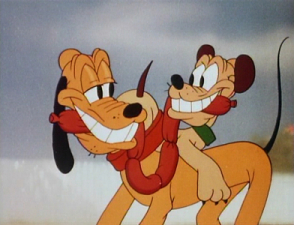
Featuring Pluto, three cartoon shorts in HD, no less, are included here for some additional canine cartoon fun. From 1940’s classic Bone Trouble, through Pluto Junior from 1942, and to Pluto’s Kid Brother from 1946, these cartoons have been variously shown during the years in compilation shows and at least one featured on other DVD releases, but they’re are a decent enough selection even if Pluto’s further adventures with junior versions of himself might have perhaps been a more suitably themed choice than the often seen Bone Trouble. But…certainly these newer restored versions of the Pluto cartoons are well worth seeking out, as these prints have been given the restored and remastered treatment, with Bone Trouble especially taking on new life. A Play All option would have been nice, but an additional 23 minutes of classic Disney material is never a bad thing – and in HD to boot!
On the original DVDs, a couple of set-top games and a DVD-ROM feature with a custom Scamp interface linked to an online site, where a tour of the town, production notes, screensavers and more offered a bit of fun, but one can understand their omission here. The only thing that would have been a nice addition is a look at Scamp’s comic book history, but what we do have provides a fine general look concerning this particular production: the commentary, documentary and Pluto cartoons in HD are all very welcome surprises, while the FastPlay enabled enclosed DVD merely includes the five Sing-Alongs.
Case Study:
It seems that the video sequels to the titles placed in Disney’s Platinum, now Diamond, Edition line are either worthy of their own release or that the Studio quite rightly doesn’t want to include anything on those Diamond sets to take away from the luster of the main feature (hence why the concurrent non-Diamond Pocahontas Blu-ray includes that film’s sequel as a double feature option). So, while certain titles may find an individual release places too much status on them as anything more than the direct-to-video product they are, I must say that in Scamp’s Adventure’s case, I can’t really begrudge the attention it gets here in the form of a glossy and embossed slipcover that continues Disney’s blu-centric design. An insert offers the Movie Rewards code for the title, while a front sticker offers $10 off the title when purchased with another of Disney’s August 21 releases, good up to September 30 2012.
Ink And Paint:

Benefiting from its digital production, if anything Scamp looks a little too bright to compare to the pedigree the original film was. The backgrounds look wonderful, sometimes too dark even, but the overlaid characters are always a little too lightly colored for them. But the characters’ lines are not the strong, black, bold look of many of these direct-to-video features, instead having been individually colored in the style of the original, and these lines are well defined here with good color registration locking in without any bleed, the rounded colors of the production design coming through nice and warm. The original DVD was presented in a 1.66:1 aspect ratio, here the 1.78:1 presentation on both the BD and DVD crops the top and bottom, for some reason – not the most devastating of reframings, but still pretty pointless.
Scratch Tracks:
Perhaps as an added incentive to buying the DTV films, Disney routinely offered DTS tracks as part of the package, and Scamp was no exception, the same mix being offered here as this disc’s default. Music seeps nicely into the surrounds, and there’s a fair punch in the bass, with dialogue locked center as expected, and effects and the rousing (sometimes too loud?) music playing out over the left and right stereo pairs. This is a good track for a home video title, easily slipping into the usual Disney feature film quality sphere, and really helping lift the film into a better placing, production-value wise. English subtitles and French and Spanish language Dolby 5.1 tracks and subtitles are also included.
Final Cut:
Running a brisk sixty-nine or so minutes (including a no-less than six-minute credit scroll), Lady And The Tramp II: Scamp’s Adventure could have done with some slowing of its pace on certain scenes and letting them breathe a little. It’s something of a shame that the film was not selected to go the theatrical route (although I believe it was first released on DVD before anyone thought such a move was viable) as, even though it is fairly short, it’s largely a case of quality over quantity and never outstays its welcome. On Blu-ray, $39.99 is a high list price when the much-more bonus-packed theatricals Treasure Planet and Home On The Range went for $29.99, but online discounts make things more reasonable. In HD the lightness of the characters’ shading becomes a little more apparent, and the obviously lower cost than the original’s animation more noticeable, but if you’re a fan of the original and can get over the whole “sequel-itus” thing, Scamp still proves to be no Tramp.
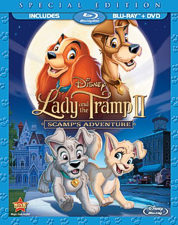 | ||
 |









